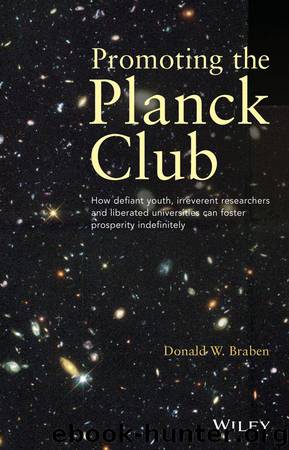Promoting the Planck Club: How Defiant Youth, Irreverent Researchers and Liberated Universities Can Foster Prosperity Indefinitely by Braben Donald W

Author:Braben, Donald W. [Braben, Donald W.]
Language: eng
Format: epub
Publisher: Wiley
Published: 2014-02-19T00:00:00+00:00
This was not the wisest remark he could have made to the independent-minded Townes as it merely increased his yearning for a return to university life. Not surprisingly, therefore, when Isidor Rabi,* chairman of the Columbia University physics department, who was impressed no doubt by his growing reputation, invited Townes to come to Columbia, he leapt at this completely unexpected opportunity and started there in 1948. The U.S. Navy also was interested in high-frequency communications and controlled radars and asked him to advise on how shorter frequencies than they had used during wartime might be generated. They agreed to provide financing to Columbia for this effort with few if any strings and also invited Townes to chair a national selection committee to advise on additional work in this field.
The ideas behind the maser's discovery had already begun to form in Townes' mind before he went to Columbia. It had been known for some years that if a molecule in an excited state were bombarded with microwave radiation (photons) whose energy (frequency) was exactly the same as that state's energy, the molecule would be stimulated into emitting a photon exactly in phase with the bombarding photon and in exactly the same direction; that is, it would be coherent with it. Thus, there would now be two photons, and each could proceed to stimulate further coherent emissions from other excited molecules, thereby eventually creating an avalanche of amplified and coherent radiation. These are necessary, even amazing, consequences of the quantum nature of these states and were first pointed out by Einstein in 1917 (Einstein 1917). However, if the molecule were in its ground state (i.e., it was not excited), an incoming photon would probably disappear by being absorbed and raising the molecule to an excited state. The molecule remains in that state for a time determined by its quantum properties, eventually spontaneously decaying to its ground state by emitting a photon of that same energy. However, that later emission would have no relationship with the original photon; that emission could happen at any time and go in any direction. Thus, the excited molecule “forgets” how it got excited, and the emitted radiation would be incoherent with the original.
Einstein would seem, therefore, to have come up with the idea for the maser! And so he had, but Einstein was exclusively a theoretician; and, in any case, the little matter of reality would have stood in the way. As everyone also knew, the probability that a molecule would be in an excited state varies inversely and exponentially with the energy of that state. This is the famous Maxwell-Boltzmann energy distribution law, according to which the overwhelming majority of gaseous molecules at ambient temperature is in the ground state and would therefore be efficient absorbers of radiation. Subsequently, that radiation would spontaneously be re-emitted, of course, but it would be incoherent. As Townes put it, “The material soaks up more photons than it surrenders.”
Thus, according to then-current understanding, amplified coherent emissions would be fundamentally impossible to achieve in practice.
Download
This site does not store any files on its server. We only index and link to content provided by other sites. Please contact the content providers to delete copyright contents if any and email us, we'll remove relevant links or contents immediately.
Enlightenment Now: The Case for Reason, Science, Humanism, and Progress by Steven Pinker(7228)
A Journey Through Charms and Defence Against the Dark Arts (Harry Potter: A Journey Through…) by Pottermore Publishing(4781)
The Immortal Life of Henrietta Lacks by Rebecca Skloot(4525)
A Journey Through Divination and Astronomy by Publishing Pottermore(4344)
Elon Musk by Ashlee Vance(4028)
Origin Story: A Big History of Everything by David Christian(3648)
COSMOS by Carl Sagan(3554)
Alchemy and Alchemists by C. J. S. Thompson(3449)
Bad Pharma by Ben Goldacre(3355)
Enlightenment Now by Steven Pinker(3335)
Shadow of Night by Deborah Harkness(3301)
Inferior by Angela Saini(3276)
A Mind For Numbers: How to Excel at Math and Science (Even If You Flunked Algebra) by Barbara Oakley(3217)
Origin Story by David Christian(3147)
The Code Book by Simon Singh(3074)
Signature in the Cell: DNA and the Evidence for Intelligent Design by Stephen C. Meyer(3071)
The Elements by Theodore Gray(2998)
A Brief History of Time by Stephen Hawking(2960)
A Journey Through Potions and Herbology (A Journey Through…) by Pottermore Publishing(2826)
